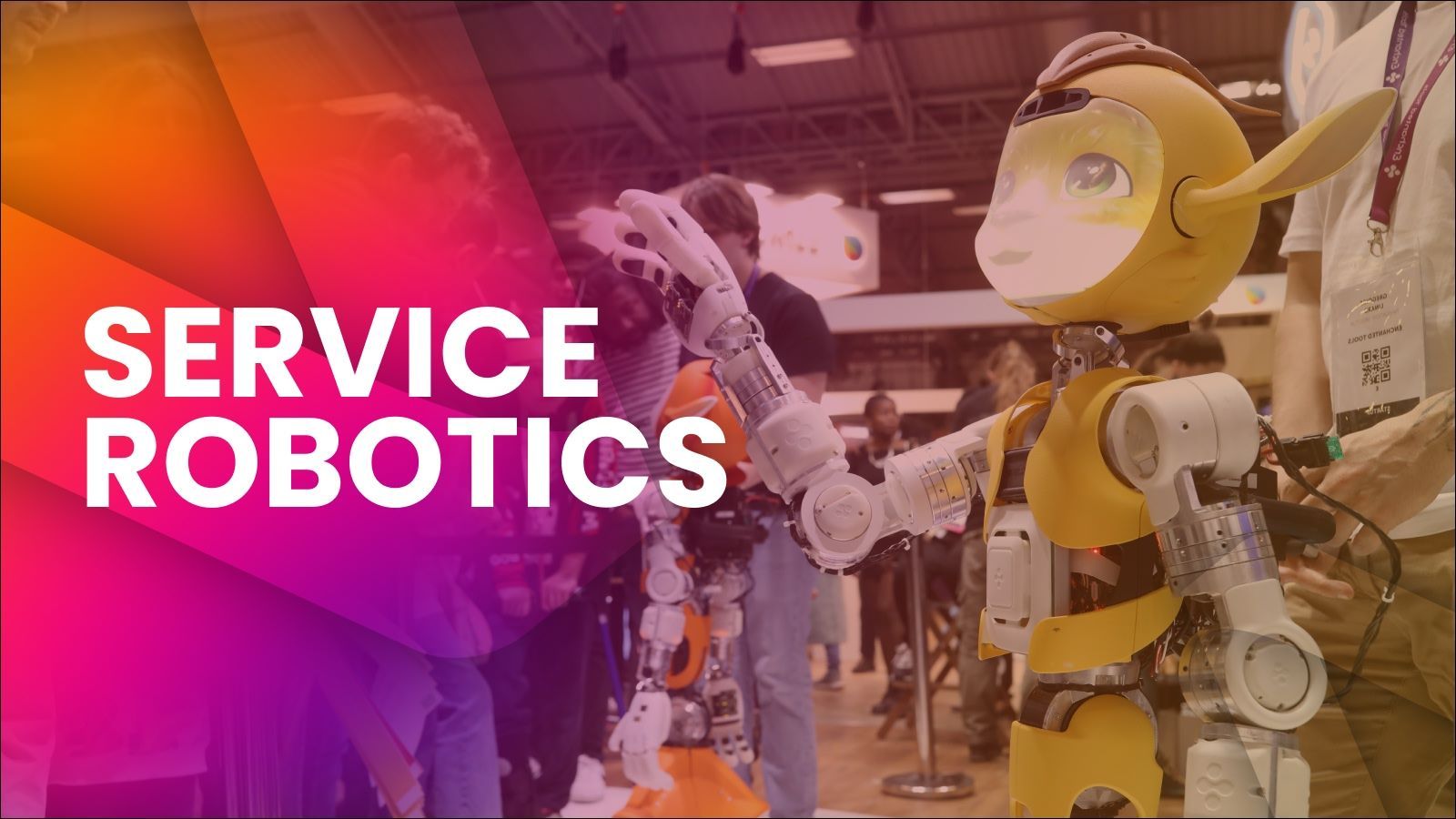
Service robots are already making human life easier and safer, even if you don’t yet notice them in action. Around the world they are cleaning, improving healthcare and carrying heavy loads.
The field of service robotics is rapidly evolving, with innovations pushing these machines forward in areas such as healthcare, hospitality, retail, and logistics. This guide explains what service robotics is, how these robots are already impacting your life, and what they are likely to achieve in the future.
What Does ‘Service Robotics’ Mean?
Service robotics is a category of robots designed to assist humans by performing tasks in non-industrial situations. Industrial robots operate on factory floors and assembly lines, while service robots are found in settings ranging from homes and hospitals to restaurants and sidewalks.
The main goal of service robots is to increase convenience, efficiency, and safety by automating repetitive, time-consuming, or dangerous tasks. These robots are equipped with advanced technologies such as sensors, cameras, and artificial intelligence (AI) to interact with their surroundings, process data, and make decisions autonomously.
Examples of Service Robotics in Action
Service robotics can be used in a huge variety of ways, which shows how versatile and full of potential these robots are.
Standout examples of service robotics already in use include:
Healthcare Robots: Arguably the biggest impact of service robotics today is in hospitals and other healthcare settings. Service robots are helping save lives and improve health outcomes by drawing blood efficiently and accurately, delivering medications, and disinfecting hospitals to reduce acquired infections. Robots are already acting as precise surgical assistants, nurses and rehabilitation aides that are transforming human care. Robotics company Enchanted Tools created the Mirokaï robot to assist nurses in hospitals and enhance patient care.
Hospitality Robots: In hotels and restaurants, service robots can be used for room deliveries, greeting guests, or even cooking meals. Robots like SoftBank’s Pepper can greet customers, answer questions, and provide recommendations. Hospitality robots aim to reduce wait times and improve guest experience.
Retail and Customer Service Robots: Retailers such as Lowe’s, Walmart and Giant Food have tested robots to stock shelves, scan inventory, clean up spills, and assist customers.
Household Robots: Home cleaning robots like iRobot’s Roomba, robotic lawn mowers, or even robotic pet companions that reduce stress levels, are examples of service robots already popular in homes.
Security and Surveillance Robots: These robots patrol areas, monitor for unusual activity, and enhance security in public spaces, shopping malls, or corporate buildings.
Airport Robots: Tasks such as security screening, baggage handling and even chasing birds off airport runways are being made easier by robots. Machines such as the evoBOT have gripper arms and are being used to lift and transport parcels, load and unload aircraft, and handle hazardous goods.
You can meet many service robots in person at VivaTech. In 2024, service robotics exhibited included Softbank’s Pepper, Blue Frog Robotics’s AI-powered assistance robot Buddy, and ipsum tek’s ONYRO hospitality robot that can fulfill and deliver hotel room service orders.
Autonomous Delivery Vehicles and Their Future Implications
Autonomous delivery vehicles are robots designed to transport packages, groceries, meals, and other goods from distribution centers or stores directly to consumers’ homes. The rise of e-commerce and demand for faster, more convenient deliveries is pushing the development of these autonomous delivery robots.
Perhaps the most visible example of service robotics, autonomous delivery robots rely on a combination of technologies to navigate and perform their tasks including GPS and mapping, sensors and cameras, and AI and machine learning.
The potential for autonomous delivery robots extends beyond consumer goods as well. They can be used in dangerous situations such as conflict zones or natural disasters to deliver medical supplies, food, and water.
Serve Robotics: The Business Behind the First Truly Public-Facing Service Robotics
One of the most high-profile examples of autonomous delivery robotics is the work of Serve Robotics. Originally part of Uber, Serve Robotics focuses on creating sidewalk delivery robots that transport food and goods over short distances. These robots are one of the first truly public-facing implementations of service robotics, and their futuristic design attracted enormous attention.
Serve Robotics’ delivery robots operate on sidewalks and are designed to safely and precisely navigate cities. The company has partnered with Uber Eats to offer customers autonomous food delivery in Los Angeles, California. This collaboration could prove the technology’s potential to become a standard feature in urban deliveries.
While other service robotics applications have existed for years, Serve Robotics’ sidewalk delivery robots are the first to truly bring this technology into everyday life.
Challenges Preventing Wider Rollout of the Technology
Despite their potential, service robotics face significant challenges that limit their widespread adoption, including:
Technical Challenges
Unpredictable Environments: Navigating urban settings with variables such as traffic, construction, and crowded sidewalks is a major hurdle for autonomous robots.
Battery Life: Limited battery life can restrict the range and operational time of service robots, especially those performing energy-intensive tasks.
Weather Conditions: Rain, snow, and extreme temperatures can affect the performance and reliability of delivery robots.
Regulatory and Legal Challenges
Legislation: The deployment of service robots in public spaces often requires navigating a patchwork of local regulations. Laws governing sidewalk robots in particular vary widely by region.
Liability Issues: Determining who is responsible in case of accidents or malfunctions is another unresolved issue.
Economic Barriers
High Initial Costs: The research, development, and production of advanced service robots requires significant investment, making them prohibitively expensive for many businesses.
Return on Investment (ROI): Companies need assurance that deploying service robots will provide clear financial benefits that justify the costs.
Public perceptions towards the technology
Because service robots are highly visible, public perception and acceptance of them is critical to the field’s success. Addressing concerns about privacy, safety, and the ethical use of robotics will be key to gaining consumer trust.
For example, Walmart stopped using 500 inventory-scanning robots in its stores during the coronavirus pandemic. The company observed that many customers were uncomfortable around the six-foot tall robots, finding them intimidating or intrusive.
Design is integral to acceptance as well. Studies show that customers react more positively to robots perceived as female, and robots that show emotional communication capabilities.
Other common concerns over service robotics include fear of accidents, disruption and privacy being invaded by robots with cameras, sensors and scanners. The possibility that human jobs could be replaced by robots can also create resistance to their adoption.
As service robotics technology advances, service robots will become more capable, affordable, and widely accepted. Autonomous delivery vehicles in particular are likely to reshape how goods are transported in cities. As the challenges and opportunities for these robots develop, expect to see even more service robots in your daily life.


